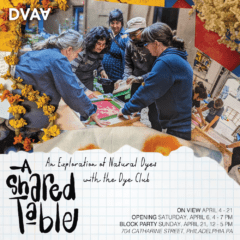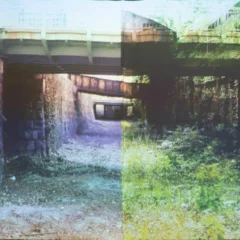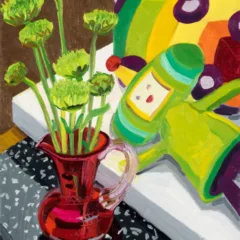
Siona Benjamin, See No Evil, in which the artist puts Queen Esther in her own shoes.
We all have some dreamy idea of a Cheers kind of life in a single town where everyone knows your name. But that doesn’t take into account the non-stop migrations around the world–people fleeing war or famine or hardship–or boredom.
Around 15 years ago, I learned that a bunch of ancient bodies were unearthed in China–all fair-haired people wearing tartans.
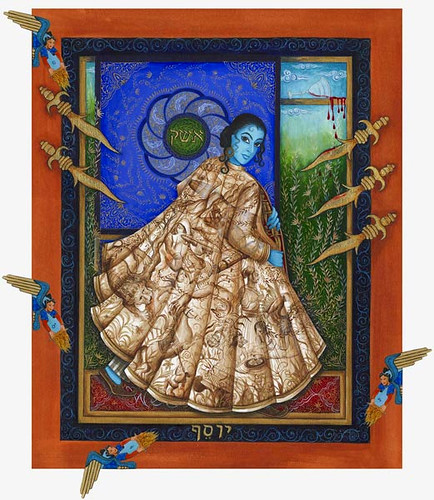
Siona Benjamin, Joseph, gouache and gold leaf on museum board, 22 x 17 inches, 2006.
And last night a tragedy in Philadelphia’s Liberian community was in the news.
So a couple of shows now on exhibition about the immigrant experience are updates of an old story, but each retelling occurs in the latest cultural context and is current because people are always on the move.
One is a group of paintings by a migrant from Bombay, Siona Benjamin, at the Philadelphia Museum of Jewish Art, at Rodeph Shalom on North Broad Street.
And the other is a group show, including paintings, installation and videos at two venues–the Asian Arts Initiative and International House.
They both gave me plenty to chew over.
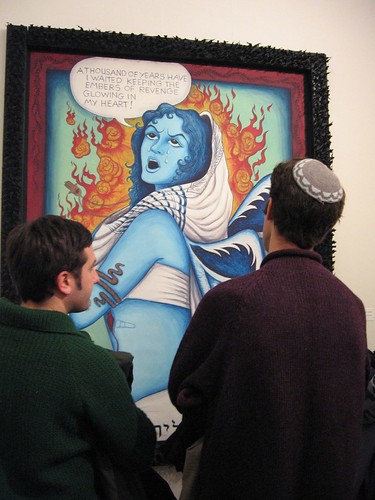
Siona Benjamin channels Bollywood movie posters and other pop sources for this personal–and political–statement. The pokey things all around the frame of this one are little plastic toy soldiers.
Benjamin, who is originally from India’s Bene Israel Jewish community (and is now from New Jersey), has created work that reflects her multiple identities–as a Jewish woman, an Indian woman, and now an American woman–and all the confusions and ironies that implies.
Her paintings include self-portraits of herself as Bluish, a la Krishna and a la Yellow Submarine. She is influenced by Bollywood film posters and Indian comics about the Hindu pantheon. She also portrays herself as Lilith and others from her Jewish studies, not to mention as a feminist in a land of confusing expections. I see bits of True Romance in there too. But the conventions of Indian miniatures with hands in traditional gestures rendered in traditional manner are also there in the mix.
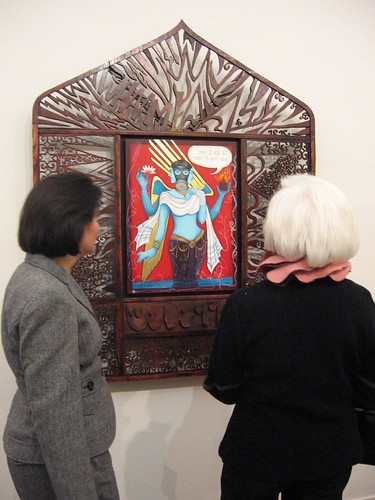
Siona Benjamin. The carved frame is a design used to frame Indian windows in palaces and in the Taj Hotel, one of the buildings taken seige recently in Mumbai.
I went the night of the panel discussion, which was also right after the Mumbai massacre, and included in the exhibit is a piece framed like a traditional Indian palace window–with ornate, arched cut-wood filigree framing the painting–the same style as windows at the Taj Hotel. In the cut-outs was the word, Wham!
Not so pretty when the Wham is for real.
Benjamin’s mother was there that night, all the way from Mumbai, where there remain only about 400 Jews.
Anyway, I was especially charmed by the large Pop images, and by one of the small images in which the blue Siona stands in a pool of water from a dripping tap in the wall, a swatter (or spatula) in hand. I’m sorry I don’t have an image of this one.
The exhibit runs to Mar. 10.
Her own sense of not being quite sure of her identity was echoed in a series of short-short films by Philadelphia video collaborative Termite TV (Michael Kuetemeyer, Anula Shetty and Francesca Soans) at International House.
The videos at International House are in the InLiquid video space there, as well as a part of a two-part show, the other at Asian Arts Initiative. Both parts of the Transplants exhibit were curated by InLiquid curator and member Sean Stoops (who used to be AAI’s curator). And I want to add that the happy siting of this particular subject matter at International House seems particularly apt.

Termite TV, a still from a video about Shetty being mistaken for a Mexican illegal at a border stop near San Diego. Much of the video from the incident was footage of cattle being corralled.
I loved the Termite TV series, about Shetty’s own identity as an Indian woman in America, and then as an American woman in other places, and the confused expectations of others in understanding who she is and what to expect of her.
I also loved the logo of the old-fashioned floating TVs, glowing in their gold and wood-color frames.
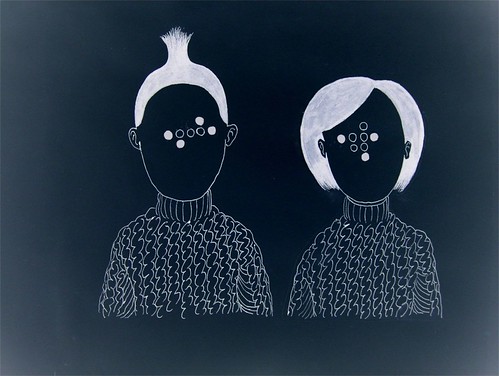
Nobutaka Aozaki, SIGNAL, 2008, video still
I was taken by several other videos, including Nobutaka Aozaki’s SIGNAL, drawings of people with push buttons instead of features on their faces, each of them having some variation in the button configuration. They reminded me of Laylah Ali’s drawings suggesting how we use fashion signals to divide and communicate our tribal affiliations.
Another favorite, Rene Marquez‘ rough video, Breed, about dog breeding and how people treat dogs–which is a metaphor for people and group identification and control and conquest of others. Also Belinda Haikes‘ dreamy poetry of longing for the veld of her past–short but moving. And Amarjett Singh’s rueful classic autobiographical video of a college graduate reduced as an immigrant to working low-level jobs. Others showing videos are Huong Ngo and Sara Suleman, in both cases not quite complete thoughts.

Nathalie Pham, Blue Duckie Exploring Spam
At AAI, I loved work from Nathalie Pham, four lacquer on panel with sign-paint fantasy drawings that were witty and Pop. The traditional lacquer technique brings a watery presence through the application of the paint. In the paintings, soda cans float and a Spam can is painted like blue-on-white Chinese porcelain.
Other standouts include Jiny Ung’s installation, The Daily Staple, an arrangement of rice bowls holding grenades above which flutter printed pages, hanging from clothelines. It’s the printed pages with their fragmentary stories that flutter on the air currents that are the surprise here.
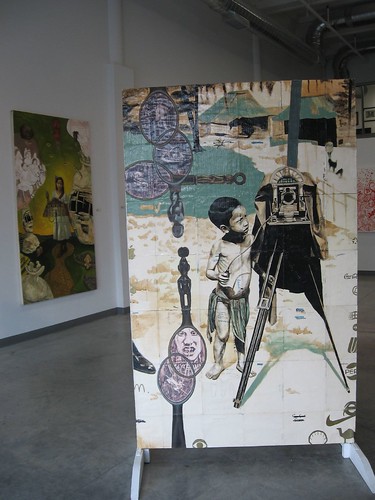
Eliseo Art Silva, Boy With Camera (foreground) and Girl With Camera (background left)
Eliseo Art Silva‘s Boy With Camera (I remember seeing this piece at Arcadia a few years ago) and Girl With Camera are unsettling. Silva, who works with Mural Arts, came here from the Phillipines.
Of the four Chinatown Youth Radio Philadelphia audio stories, XuXu Chen’s report on drying ducks and sneakers side by side in the window at Abakus on North 10th Street was lively and amusing.
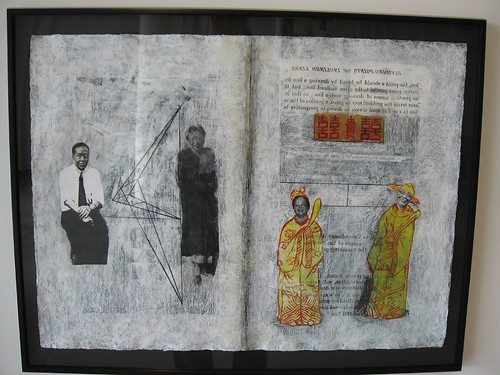
Joanna Kao’s mixed media collage/prints were evocative, especially My Mother and Father. Also showing was an interactive project by Keiko Miyamori, an installation by Romy Scheroder and a student printing project by Ben Volta with students from Grover Washington Middle school.
The mix of student work and professional art made the exhibit a little more uneven than usual, but there was still plenty here that I enjoyed mining.




